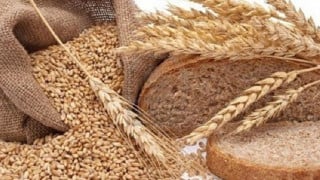Wheat is the basic food security crop. The coronavirus pandemic naturally gave rise to questions among the populace whether or not Georgia has a sufficient wheat reserve and will the current situation hamper wheat import to the country.
In 2019, the area sown with wheat in Georgia was 46.3 thousand hectares whilst the wheat yield amounted to 101,000 tonnes. The average wheat yield per hectare was 2.5 tonnes.
According to the National Statistics Office of Georgia, Georgia’s wheat consumption was 764,000 tonnes in 2019. Of that amount, food consumption was 638,000 tonnes. Of the total amount of consumed wheat, local production is 101,000 tonnes whilst import constitutes 687,000 tonnes. Therefore, 77% of Georgia’s total wheat consumption as of 2019 is import and only 13% is local production (10% are the opening stocks at the beginning of a year).
Over the course of 2020 (January-May), a total of 491,000 tonnes of wheat valued at USD 42,55.7 thousand was imported to Georgia. This is 8.8% more in monetary value and 14.4% more in terms of quantity.
Table 1: Wheat Import in January-May 2019-2020 (USD Thousand, Tonnes)
|
Year |
January |
February |
March |
April |
May |
Total |
|
2019 (USD) |
7,578.1 |
8,016.1 |
7,215.4 |
9,769.5 |
6,239.1 |
38,818.2 |
|
2020 (USD) |
7,775.5 |
5,058 |
8,756 |
8,624.1 |
12,042.1 |
42,255.7 |
|
2019 (Tonne) |
34,080.3 |
36,602.7 |
31,619.5 |
41,294.5 |
27,165.4 |
170,762.4 |
|
2020 (Tonne) |
36,731.8 |
23,745.7 |
44,695.8 |
39,384.4 |
50,933.5 |
195,491.2 |
Source: Ministry of Finance (Export-Import)
The government programme to fix prices on staple foods supposedly also somehow affected the growth of wheat import this year. According to the programme, the government provided insurance on fixed prices for nine food products, including wheat.
With this programme, the Government of Georgia offsets the currency exchange difference to food importers meaning that the USD to GEL exchange rate was fixed at GEL 3 (USD 1 – GEL 3) and the EUR to GEL exchange rate was fixed at GEL 3.3 (EUR 1 – GEL 3.3). Any extra costs for importers over GEL 3 in the case of USD and over GEL 3.3 in the case of EUR is subsidised by the government. For instance, if the price of an imported product is GEL 3.5, the difference between the prices (GEL 0.5 in the case of USD and GE 0.2 in the case of EUR) is paid by the government. The programme’s budget is GEL 10 million.
In January-May 2020, the average wheat price was fluctuating within the margins of USD 195 to USD 236. Average five months, the price amounted to USD 198. In regard to wheat staple products – bread and flour, prices were as follows:
Table 2: Wheat Flour and Bread Consumer Price Index (Previous Month = 100).
|
Year |
January |
February |
March |
April |
May |
|
Wheat Bread |
100.28 |
100.08 |
102.05 |
99.94 |
99.94 |
|
Wheat Flour |
101.06 |
102.53 |
101.86 |
104.83 |
99.31 |
Source: National Statistics Office of Georgia
As we see, the wheat bread price increased in March amid the pandemic whilst there is a trend of decline in April and May. In regard to wheat flour, prices increased in March and April and dropped in May.
According to the preliminary data for 2019, wheat valued at USD 108,969.9 thousand was imported to Georgia. Of this amount, wheat valued at USD 90,668.2 thousand was imported from Russia. Therefore, 83.2% of the imported wheat comes from Russia and 16.8% from Kazakhstan. In 2018 (see FactCheck’s article), the total monetary value of imported wheat was USD 114,903,700 with Russia’s share in this amount valued at USD 95,783,200 (83.4%). As we see, the bulk of the wheat imported in the last two years is from Russia. In 2020, the volume and monetary value of Russia-imported wheat are as follows:
Table 3: Wheat Import from Russia in January-May 2019-2020 (USD Thousand, Tonnes)
|
Year |
January |
February |
March |
April |
May |
Total |
|
2019 (USD) |
4,995.1 |
6,215 |
4,757.9 |
5,927.7 |
4,271.7 |
26,167.4 |
|
2020 (USD) |
6,104.3 |
4,111 |
8,755.2 |
8,478.3 |
11,871.5 |
39,320.3 |
|
2019 (Tonnes) |
22,070.3 |
28,493.5 |
21,005.5 |
25,948.6 |
19,552.4 |
117,070.3 |
|
2020 (Tonnes) |
27,731.9 |
18,645.7 |
40,195.9 |
38,458.4 |
50,013.9 |
175,045.8 |
Source: Ministry of Finance (Export-Import)
In the first five months of 2020, Russian-imported wheat accounts for 93% of the total import. The share of US-imported wheat is 7%.
The need for a diversification of wheat import has become particularly relevant amid the coronavirus pandemic. It is important for food security to have a diversified wheat import to avoid the risk of a wheat supply deficit and be less dependent on an unreliable trade partner such as Russia which often uses trade relations with Georgia for political purposes.







